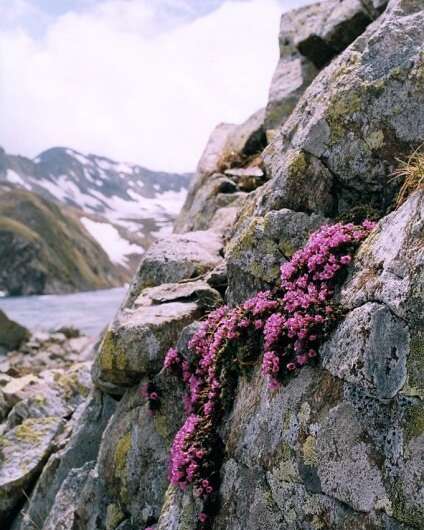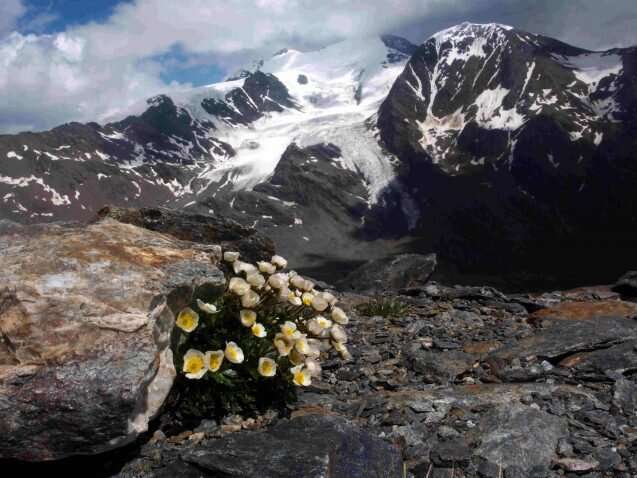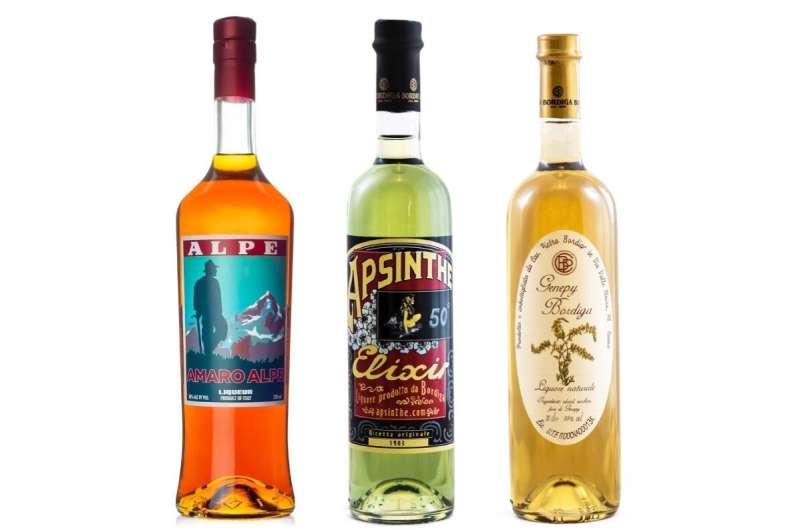Retreating glaciers threaten herbs used to make iconic alpine liqueurs

Alpine landscapes are irrevocably changing: scientists estimate that the Alps may be glacier-free by the end of this century. As the ice melts, the unique ecosystems that exist at their edges are also fading. New research published in Frontiers in Ecology and Evolution untangled what changing flora might mean for the ecology, economy and culture of the region.
The Alps, known for their meadows brimming with wildflowers in the spring and summer, are home to many plants that are specialized for glacial growing conditions. Many of these plants are fragrant herbs, some of which have been used to make medicines and liqueurs for centuries. These distinctive, native plants have become an important part of the culture and economy of the mountains. The herbs are part of a landscape that hosts a dynamic, evolving system of plants that scientists are watching shift in real-time.
As glaciers retreat, they expose new land which is readily colonized by plants. "The retreat of glaciers is a double-edged sword," said lead author Gianalberto Losapio in an interview with GlacierHub. "There is an initial increase in biodiversity because the retreating glaciers are making space available. If today there is ice and the glacier is retreating, it means that tomorrow there might be new terrain because the ice is gone, which means that seeds can grow."
At the fringes of a glacier, the soil that is exposed is often not well-suited to hosting plant life. There is often more rocky debris than soil, and the soil that is present is not always rich in the nutrients that plants need. Many native Alpine herbs have carved out a niche for themselves in these proglacial areas. These plants, which survive where others cannot, are called "pioneers" by ecologists. "The initial plants, the pioneers, are adapted to living in this harsh environment," said Losapio.
The pioneer species are often small and low to the ground. They don't need much in the way of soil or nutrients to grow. In the past, these early settlers were the only plants able to survive at the edges of a glacier. Now, with year-round ice-free ground, the proglacial habitats are narrowing.

The pioneer species not only establish themselves, but also prime the land for new plants to thrive by building up biomass and providing nutrients. "These early plants improve the environment in such a way that other plants can benefit from," said Losapio. "The higher the colonization, the more this facilitation and mutualistic interaction take place, which increases biodiversity."
After the early plants have done the work of stabilizing the landscape, other plants move in. The later species that enter are not as well-suited for the difficult initial growing conditions as the pioneer plants are, but thrive on the land primed by them. In the past, the ice returned after a few short months and later species did not have time to establish. But now, with many glaciers disappearing and the annual period of snow cover shrinking, the later species have a new opening.
As the later species move in, the dynamic of the area changes. "The arrival of the late species increases the competition," said Losapio. "They require more organic matter and they also reproduce vegetatively, not with seeds, so they occupy much more of the space."
The later plants piggy-back off the conditions that the hardy, early species help create. And then, they take over. The later species reproduce much faster than the pioneer species, and take up more resources, leaving little space for the slower-growing plants that came before them.
Many of the early species, including Arctic buttercup, saxifrage, and wormwood, simply cannot compete with these fast-growing newcomers. Eventually, the later species might be all that is left on high-elevation Alpine land. "The area is going to be much more dominated by grasslands," said Losapio. "This is going to decrease biodiversity in general."
These effects extend beyond just the plants; insect populations could suffer, too. "We also observed a decline in insect-pollinated species," explained Losapio "[Insect] populations are very high in pioneer and initial stages, but the plants in grasslands are not usually pollinated by insects."
In addition to changing the appearance and biodiversity of the area, the shifts due to deglaciation could also have economic and cultural impacts. Among the pioneer plants that are being squeezed out is Artemisia genipi, often called simply genipi, genepy or black wormwood. "Artemisia genipi is a very rare, iconic plant. Already, after 100 years of glacier retreat, it has been declining," said Losapio. "Its distribution is very narrow. It grows only in the northwestern Alps. Culturally it is super important. Hikers up in the mountains go and they stop at a hut, they have a piece of cake and a shot of genepi."
Varieties of Artemisia have been used throughout Europe since Roman times as a key ingredient in medicines. "Genepi varieties have historically been used in folk and traditional medicine because of their bioactivity," said Alessio Anselmo, an herbal technician with Italian Alpine liqueur producer Bordiga, in an interview with GlacierHub. "They were known and used as thermogenic agents against the common cold, in infusions against fever, and in aromatic wines and liqueurs to stimulate appetite and digestion."
Centuries of production of Artemisia genipi–infused drinks has led the flavor to become an emblem of the region. "To produce genepi liqueur, the aerial parts and flowers are introduced into a hydroalcoholic solution and rest lightless at ambient temperature for 40 days," explains Anselmo. "Then the solid parts are pressed with a hydraulic press and the infusion rests for some months. Finally, the infusion is mixed with alcohol, water and sugar, filtered and bottled."
Traditional recipes for absinthe, Chartreuse, amari and various other alpine liqueurs use Artemisia genipi as a key ingredient. "Artemesia genepi is a type of wormwood and as such, adds a bitter vegetal flavor to the spirit," said David Curiel, spirits specialist with the importer Oliver McCrum Wines & Spirits in an interview with GlacierHub. "It's a distinct alpine flavor that embodies the sense of place."
Today, producers throughout the Alps continue to make liqueurs and fortified wines using Artemisia and other Alpine herbs. Once primarily consumed by chilly mountain hikers as a respite from Alpine snow and ice, Artemisia genipi has found a new home in cocktail bars across the world.
"Most people [in the United States] tend to be familiar with these flavors because of Chartreuse, possibly the biggest commercial exporter of genepi, but the category is actually quite broad in Europe," said Curiel. "[In the Alps,] Artemisia genipi commonly finds itself being consumed during the colder months, maybe in a ski lodge, sitting by a fire. Here in the U.S., the craft cocktail scene seems to lean into using it in refreshing citrus-driven cocktails that you might consume in the summer while sitting on a patio, or poolside."
Even American producers have been trying their hand at Artemisia genipi–based liqueurs. At Forthave Spirits in Brooklyn, New York co-founders Aaron Sing Fox and Daniel de la Nuez have been making botanical liqueurs since 2013. "Genepi has a very complex, enchanting and difficult to describe flavor," Fox told GlacierHub. "We wanted to make something that highlighted the delicate aspects of this botanical so we used it to make a wine-based aperitif."
Fox and de la Nuez source their Artemisia genipi not from the wild, but from a grower in the Alps who cultivates a very limited crop each year. Still, the loss of wild genipi looms large. "The loss of wild genepi would be heartbreaking," said Fox. "There is much more to learn and explore from the many wild genepi species that are out there."
More information: Gianalberto Losapio et al. The Consequences of Glacier Retreat Are Uneven Between Plant Species, Frontiers in Ecology and Evolution (2021). DOI: 10.3389/fevo.2020.616562
Journal information: Ecology and Evolution , Frontiers in Ecology and Evolution
Provided by Earth Institute at Columbia University
This story is republished courtesy of Earth Institute, Columbia University http://blogs.ei.columbia.edu.





















